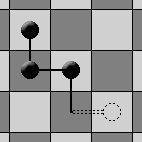| Visão Geral |
 Alternator é um jogo de tabuleiro para dois jogadores inventado em 2003 por Gregory Keith Van Patten (vanpag@alum.rpi.edu). Alternator é um jogo de tabuleiro para dois jogadores inventado em 2003 por Gregory Keith Van Patten (vanpag@alum.rpi.edu).
|
| Board |
|
Alternator é jogado sobre um tabuleiro comum de xadres 8 x 8 : E portanto, com 68 casas: 32 brancas e 32 pretas. Cada casa do tabuleiro plano pode ser descrita através de duas coordenadas (Letra, Número), por exempo, a primeira casa no canto esquerdo superior é (A,8)
|
| Objetivo do Jogo |
|
O objetivo do Alternator é obter uma pontuação maior que o seu oponente após ambos os jogadoes terem completado uma partida. A pontuação de cada jogador é a soma dos tamanhos de todas as árvores que ele conquistou. |
| Como Jogar | ||||||||||||
|
Há dois jogadores no jogo. O primeiro jogador usa as casas pretas e o segundo jogador as casas brancas. Os jogadores se movimentam alternadamente, começando com o jogador que controla as peças pretas. Um movimento consiste de duas partes. Primeiro, draw a dot no dentro de uma casa, que ainda não tenha uma dot. Segundo, draw uma linha reta desta dot ao centro de uma casa adjacente que ainda não tenha uma dot. A linnha conecta duas casas adjacentes tendo cores opostas. A casa contendo o dot é chamada de "PIT". A linha é chamada de "STEM". A casa contendo a extremidade da linha sem dot é chamada de "RAIZ". A "PIT" e a "STEM" juntas formam uma "CHERRY". Nota importante: o jogador controlando as casas pretas pode colocar a "CHERRY" with its "PIT" on either a casa preta ou uma casa branca. Como também o jogador controlando as casas brancas.
When you move, it is permitted to draw a new "PIT" on the "ROOT" of some "CHERRY" already on the board:
As the game proceeds, "CHERRIES" become connected to other "CHERRIES", by their "STEMS". A connected group of cherries is called a "TREE". For every "TREE", there is exactly one cell, which is not a "PIT", but which forms the "ROOT" of at least one "CHERRY" in that "TREE". This cell is called the "TREE’S ROOT". Note that a single "CHERRY" is just a special case of a "TREE".
It is possible to merge two separate "TREES" whose "ROOTS" occupy adjacent squares. This is accomplished by placing the "PIT" of a new "CHERRY" over the "ROOT" of one of these "TREES" and the "ROOT" of that "CHERRY" in the cell containing the "ROOT" of the other "TREE":
If two "TREES" can merge, but one has larger size than the other, then the larger "TREE" must be attached to the smaller "TREE". In other words the "CHERRY" which merges "TREES" must have its "PIT" on the "ROOT" of the larger "TREE" and its "ROOT" on the "ROOT" of the smaller "TREE". The "ROOT" of the resulting "TREE" will be on the cell, which contained the "ROOT" of the smaller of the two original "TREES". When two "TREES" of equal size merge, it does not matter which "ROOT" becomes the "ROOT" of the resulting "TREE". Below are several examples:
A player may always pass on his turn. The game ends when both players pass on consecutive turns. A player’s score is the sum of the sizes of all the trees which he owns. The player with the higher score wins. |
| Komi |
|
Para compensar uma vantagem do primeiro movimento, o jogador que owns white trees pode obter alguns pontos adicionais, chamados komi. O valor do komi é acordado entre os dois jogadoes antes de começar o jogo. O autor sugere usar 3.5 como um valor para Komi. Valores não inteiros são usados de modo a evitar draws. |




















